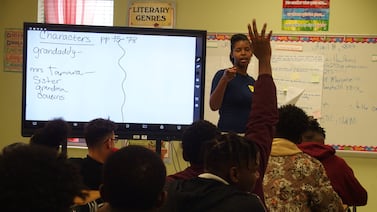Sign up for Chalkbeat Newark’s free newsletter to get the latest news about the city’s public school system delivered to your inbox.
Only 73 teen voters – out of 1,851 who had registered – turned out for Newark’s historic school board election despite weeks of targeted efforts to get the city’s 16- and 17-year-olds out to the polls.
The April 15 election was the first since the city lowered the voting age for school board elections to 16 – and Newark leaders had hoped a new wave of teen voters would boost turnout.
But, overall, only 3.47% of Newark voters participated in the election, slightly below the 3.94% turnout rate among the city’s youth voters – and about average for school board elections, in which 3% to 4% of voters typically participate.
At the beginning of February, local organizations and school leaders launched campaigns, hosted voter education events, and promoted registration drives to mobilize young voters who gained their right to vote in Newark school board elections in 2024. The efforts also drew Gov. Phil Murphy, Newark Mayor Ras Baraka, and other elected officials, who visited a Newark high school to reinforce their support for the teen vote in school board elections statewide.
This year’s youth voters also faced challenges in getting to the polls, registering to vote, and understanding who to vote for.
Turnout in local elections can be half or even less than that of presidential elections, according to Nonprofit VOTE. In Newark, turnout for school board elections may be dampened because they are held in April.
The Newark Board of Education has the authority to move the election to November, when voter turnout is typically higher due to the general elections. Such a move could also save money because the cost of November elections are typically covered by the county.
Paul Brubaker, the district’s communications director, and Hasani Council, the school board’s president, did not respond to questions about this year’s turnout, the idea of moving the election to November, or whether they discussed other options to boost participation.
Despite the low turnout, Assatta Mann, senior community organizer for the New Jersey Institute for Social Justice, said this year’s election laid the foundation for future 16- and 17-year-old voters. The learning curve for youth and the short time frame to register teens, coupled with existing voter challenges, impacted the teen vote this year, Mann said.
“I do think that going forward in future elections we will see the turnout rise, and hopefully, in part because some changes will be made to make voting easier and accessible, especially for this group of voters,” Mann added.
Newark’s youth faced voter hurdles in this election
Newark became the first city in New Jersey last year to lower the voting age to 16 for school board elections. But the youth vote was delayed until the 2025 election due to voter registration issues, city officials had said.
The decision to lower the voting age posed challenges for advocates who began registering voters on Feb. 1 and ahead of the March 25 deadline. They also faced challenges in ensuring teens were educated on the candidates to cast an informed vote on April 15.
Some teen voters faced the same problems adults faced when they showed up to vote on election day, Mann said. Some found out they weren’t registered to vote, while others found it difficult to get to the polls due to transportation issues, jobs, and after-school activities, Mann added. Additionally, Newark Public Schools students were not allowed to leave class during the school day to vote unless their school was their designated polling place.
Newark’s teens had also said they were eager to participate in the school board election, but had basic questions about the functions of a city school board and what board members do. Organizations such as The Gem Project hosted civic training sessions to educate Newark’s teens, and the NAACP Newark held a candidate forum along with city teens. The district had launched a Vote 15+ voter registration campaign where they held registration drives in high schools, but local organizations were not part of the effort.
“In spite of all these challenges, we still saw youth come out at 4%, which was higher than the adult vote,” Mann added. “Long term, it’s a good sign for civic engagement. And the possibilities for democracy, youth power building.”
Under state law, school districts are required to provide eligible voters with registration forms, a summary of voter registration eligibility requirements, materials describing the role of a citizen, and information that highlights the importance of voting, but they are not required to provide information about local elections.
What can help boost voter turnout in school board elections?
Advocates like Mann said local leaders could adopt new measures to boost turnout and increase access to the polls. New initiatives such as same-day voter registration and early voting for school board elections could help increase participation, Mann said.
Students being able to vote during lunch, civic education in schools, and allowing residents to vote at any polling place could also help, Mann added.
“I think going forward, more school-wide events, assemblies, initiatives like that, that promote this opportunity for young people to participate in our democracy will go a long way towards making sure that they do,” Mann said.
Despite their importance, local elections are often held at odd times of the year and usually receive less attention, but switching the school board election to November’s general election could help.
“All of the towns that still have school board elections in April usually have lower turnout rates than those in November,” Mann added.
Before 2012, all school board elections in New Jersey were held in April when residents voted for board candidates and the district’s budget. But in January 2012, former Gov. Chris Christie signed legislation that allowed districts to move their elections to November. Roughly 527 school districts have since moved their board elections to November, according to an estimate from the New Jersey School Boards Association. Across the state, 14 districts still hold April elections.
One of the reasons for keeping these elections in the spring was to continue to allow residents to vote on the district’s annual budgets. But in 2024, Murphy signed legislation that eliminated the requirement for certain school districts to hold a vote on their budgets in April unless their proposed budgets are above the 2% tax levy cap. The legislation also allows districts that hold November elections to ask voters to approve additional funds or to issue school bonds in an April election.
It’s unclear why Newark continues to hold elections in the spring, which come at a cost for the district.
The county covers the costs of elections held in November, according to an official at the Essex County Clerk’s Office. That could be a financial incentive to move elections since the cost of holding a school board election in April could be upwards of $30,000, according to Marc Zitomer, a partner at the Schenck, Price, Smith and King law firm.
There’s still a long way to go to boost turnout in the school board election and encourage teens to participate, Mann said. But she also believes there was a missed opportunity to create partnerships between local organizations and schools to create greater efforts to reach teens and all voters.
“I would encourage the district and the charter schools to look at some of the local organizations as partners,” Mann added. “I think we’re all working with the same goal to support young people and make sure they have the opportunity to vote.”
Jessie Gómez is a reporter for Chalkbeat Newark, covering public education in the city. Contact Jessie at jgomez@chalkbeat.org.




